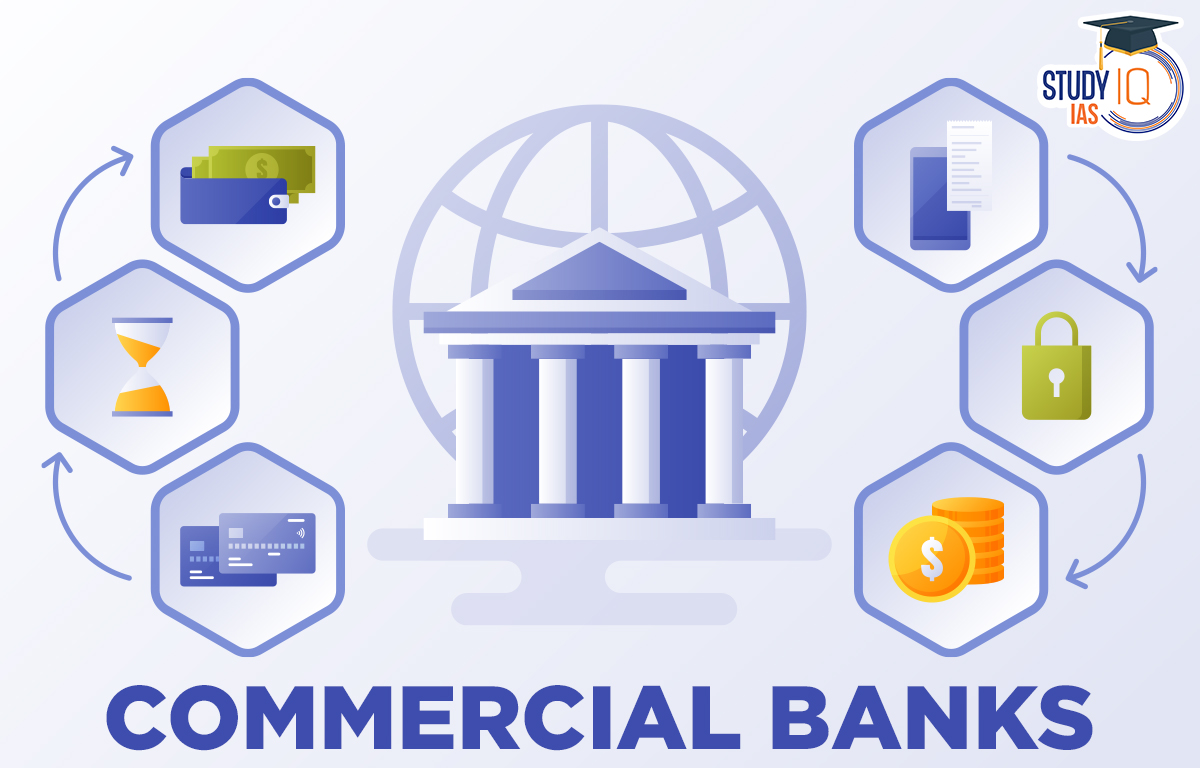
Commercial banks are profit-based institutions that offer financial products to their customers. Know all about Commercial Banks Functions, Definition, Types & Roles in this article.
Last updated on May 26th, 2024 01:18 pm

Table of Contents
Commercial banks are financial institutions that are primarily engaged in accepting deposits from individuals and businesses and providing loans and credit facilities to borrowers. They are for-profit organizations that operate with the primary objective of generating profit for their shareholders.
Commercial banks are also known as retail banks or universal banks as they provide a wide range of services to retail customers, including payment services, investment services, and foreign exchange services, in addition to their core functions of deposit-taking and lending. Commercial banks are regulated by the central bank of the country and are subject to various regulatory and supervisory requirements to ensure the safety and soundness of the banking system.
Commercial Banks play a crucial role in the economy by providing various financial services and products to individuals, businesses, and governments. Functions of Commercial Banks are classified into Primary Functions and Secondary Functions.
The primary functions of Commercial Banks revolve around the mobilization of funds from the public and the allocation of these funds to borrowers who require them for their various financial needs, thereby facilitating economic growth and development.
The primary functions of commercial banks include:
Commercial banks accept deposits from individuals and businesses, including checking accounts, savings accounts, and time deposits such as certificates of deposit (CDs).
Banks lend money to individuals and businesses for various purposes, such as buying a home, starting a business, or funding a project.
Banks provide customers with a chequebook, which they can use to write checks for payment.
Banks process checks written by their customers and those deposited by other banks.
Banks maintain account records for their customers, including transaction history, balances, and interest earned.
Banks offer safe deposit boxes for customers to store valuables and important documents.
Banks provide currency exchange services for customers who need to convert one currency to another.
Banks offer overdraft facilities to customers who need to borrow money temporarily to cover short-term expenses.
The modern functions of commercial banks have evolved from the conventional functions of commercial banks in response to changing customer needs, technological advancements, and economic conditions. They can also be called as secondary functions of commercial banks. Here are some examples of how modern functions have evolved from conventional functions:
With the advent of electronic payments, commercial banks have evolved their payment services to include online bill payment, mobile banking, and person-to-person payments.
Credit and debit cards have become a ubiquitous part of modern banking, but they were not always available. In the past, banks primarily issued checks and travellers’ checks as a means of payment.
Commercial banks have expanded their investment services to include a wider range of products, such as mutual funds, exchange-traded funds (ETFs), and online investment platforms.
While commercial banks have always offered foreign exchange services, the rise of global trade and travel has led to an increased demand for these services.
Banks have expanded their product offerings to include insurance products, such as life insurance and property insurance, to meet the changing needs of customers.
Banks have expanded their financial advice services to include retirement planning, investment advice, and debt management, as customers seek more guidance and support in managing their finances.
The types of commercial banks include:
These banks are owned and controlled by the government, and they provide banking services to the public. Examples include State Bank of India, Punjab National Bank, and Bank of Baroda.
These banks are owned and controlled by private entities, and they provide banking services to the public. Examples include HDFC Bank, ICICI Bank, and Axis Bank.
These banks are headquartered in foreign countries and have branches or subsidiaries in India. Examples include Citibank, Standard Chartered Bank, and HSBC Bank.
These banks are set up with the objective of providing banking services to rural areas. They are sponsored by a public sector bank, a private sector bank, or the government. Examples include Narmada Jhabua Gramin Bank, Pragathi Krishna Gramin Bank, and Baroda Uttar Pradesh Gramin Bank.
These banks are owned and controlled by members who use the banking services provided by the bank. Examples include Urban Co-operative Banks and Rural Co-operative Banks.
The functions of commercial banks are an important topic for UPSC (Union Public Service Commission) aspirants as it is included in the UPSC Syllabus under the Economics section of the General Studies Paper III. Understanding the functions of commercial banks is crucial for candidates preparing for the UPSC Civil Services Exam as it is a part of the Indian Economy and banking sector, which is an important component of the Indian Financial System.
Moreover, the topic of commercial bank functions is often included in the StudyIQ UPSC Online Coaching and UPSC Mock Test, which are popular resources for UPSC aspirants. Through these resources, candidates can gain a deeper understanding of the traditional and modern functions of commercial banks and how they have evolved over time. This can help candidates to answer questions related to banking and financial services in the UPSC Prelims and Mains exams.
Additionally, a strong understanding of the functions of commercial banks can also help candidates in the Essay paper, where they may be asked to analyze the role of banking in the Indian economy or discuss the impact of digital banking on the traditional functions of commercial banks.